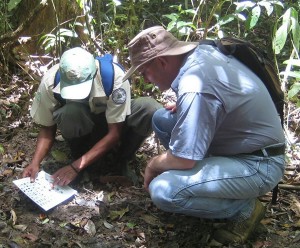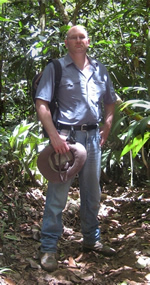Tracking the Chupacabra
Hear Ben read the first chapter
Tracking the Chupacabra: The Vampire Beast in Fact, Fiction, and Folklore
Author: Benjamin Radford
Ben Radford’s Tracking the Chupacabra was nominated as a Finalist for the 2011 Book of the Year Award in the social science category, and was a Finalist for the New Mexico Book Awards.
Among the monsters said to roam the world’s jungles and desolate deserts, none is more feared than the chupacabra—the blood-sucking beast blamed for the mysterious deaths of thousands of animals since the 1990s. To some it’s a joke; to many it is a very real threat and even a harbinger of the apocalypse. Originating in Latin America yet known worldwide, the chupacabra is a contradictory and bizarre blend of vampire and shapeshifter, changing its appearance and characteristics depending on when and where it is seen.
Rooted in conspiracy theory and anti-American sentiment, the beast is said to be the result of Frankenstein-like secret U.S. government experiments in the Puerto Rican jungles. Combining five years of careful investigation (including eyewitness accounts, field research, and forensic analysis) with a close study of the creature’s cultural and folkloric significance, Benjamin Radford is the first to fully explore—and solve—the decades-old mystery of the chupacabra.
Benjamin Radford. 288 pages. University of New Mexico Press. ISBN: 9780826350152.
Praise for Tracking the Chupacabra


Chapters
Chapter 1. The Goatsucker Mystery
Chapter 2. A Brief History of Vampires
Chapter 3. Chupacabras in Popular Culture
Chapter 4. Searching for Chupacabras in Nicaragua
Chapter 5. The Dead Vampires Speak: Chupacabra Carcasses
Chapter 6. The Curious Case of the Cuero Chupacabra
Chapter 7. Reconsidering the Goatsucker
Chapter 8. The Zoology of Chupacabras and the Science of Vampires
Appendix 1: Comparison of Ten Notable Chupacabra Reports, 1995–2010
Appendix 2: How to Identify a Chupacabra
Appendix 3: 2010 Interview with Madelyne Tolentino
Sneak Peek
Among the monsters said to roam the world’s desolate deserts and dense jungles, perhaps none is more feared than the bloodthirsty chupacabra. Rooted in conspiracy theory and anti-American sentiment, the chupacabra is a contradictory and bizarre amalgamation of vampiric monster, folk myth, and chameleon. It is a shapeshifter, changing its appearance and characteristics according to the time and place it is seen, and according to the beliefs and expectations of those who see it.
Bigfoot, the mysterious bipedal beast said to roam the North American wilderness, is named after what it leaves behind: big footprints. Bigfoot’s Hispanic cousin, the chupacabra, is also known less for what it is than for what it leaves behind: dead animals. Though goats are said to be its favorite prey (chupacabra means goat sucker in Spanish), it has also been blamed for attacks on cats, sheep, rabbits, dogs, chickens, ducks, hogs, and other animals.
Descriptions of the chupacabra vary widely, but many accounts suggest that the creature stands about four to five feet tall. It has short but powerful legs that allow it to leap fantastic distances, long claws, and terrifying black or glowing red eyes. Some claim it has spikes down its back; others report seeing stubby, bat-like wings. Some say the stench of sulfur taints the air around chupacabras, or that it emits a terrifying hiss when threatened.
While some mistakenly believe that chupacabra sightings date back to the 1970s, the chupacabra first gained real notoriety in 1995 in Puerto Rico. No one knew for certain why or how the chupacabra seemingly suddenly sprang into existence, but many Latin Americans believe it is the unholy creation of secret US government experiments in the jungles of Puerto Rico. It had a heyday of about five years, when it was widely reported in Mexico, Chile, Nicaragua, Spain, Argentina, Brazil, and Florida, among other places.
The chupacabra can be categorized as appearing in three different physical forms (and countless cultural ones). The “original” and best known is that of a five-foot-tall bipedal creature with long claws and a distinctive row of spikes down its back, reported in August 1995 by Puerto Rican eyewitness Madelyne Tolentino. The second form is a mammal from the Canidae family, a small, four-legged beast looking very much like a dog or a coyote. The third is a catchall category that basically includes any unusual animal, alive or dead, that anyone reports seeing or thinks for whatever reason might be the dreaded chupacabra. This version of the chupacabra includes everything from a “kangaroo with wings” to a dried and misshapen ocean animal.
Whatever form it takes, in twenty years it has become a global phenomenon—the world’s third best-known monster (after Bigfoot and the Loch Ness Monster). In 2002, a writer for Fortean Times magazine noted that “[n]ot since the advent of crop circles has a strange phenomenon been so quickly assimilated into popular culture. Chupacabras is now equal to the Loch Ness Monster or Bigfoot as a cultural icon.”
Solving the Chupacabra mystery
One of the first steps in this investigation was finding out what, exactly, people believed the chupacabra to be. Since no one is certain what the beast is, the issue became what people were reporting as chupacabra.
Having spent many years investigating mystery animals, I had a pretty good idea of what the “standard” chupacabra looked like. Famous eyewitness Madelyne Tolentino said the chupacabra she saw had dark eyes that went up the temples and spread around the sides; it was about four feet high, walked like a human on two legs, and had thin arms and legs, with three fingers and toes at the end of each limb. It had no ears or nose, but instead two small airholes, and long spikes down the creature’s back.
I discovered that, while this was the most common description, there were many variations. Depending on which book you read (or whose eyewitness account you believe) the chupacabra has either a “powerful tail” or it has no tail at all; it either spends most of its time flying in the night skies—or doesn’t, since it lacks wings. It might have three fingers on each hand, or four; it might have a row of distinctive spikes running down its back—or it might not. Its ears are either “big” or they are “small or absent.” At least one person suggested that the chupacabra had language skills and could understand spoken Spanish. A farmer named Rafael Moreno was concerned that a chupacabra had taken sexual liberties with his cows. (Loren Coleman, in his 2003 book Bigfoot!, included reports of Bigfoot raping cows as well.) Most of these descriptions were from Puerto Rico around 1995, but when the beast was later reported in other countries, it took on a very different form.
Investigating the chupacabra took several years, and by paying close attention to news stories about the vampire beast I was able to track down each new sighting immediately after it occurred. In the case of the most famous beast, the “Cuero chupacabra,” I was asked to be part of the History Channel television program MonsterQuest and flew to San Antonio, Texas, to examine the frozen monster. I spent about a week interviewing the chupacabra’s owner, Phylis Canion, and examining her creature. I live in the Southwestern United States, where several chupacabra reports appeared almost literally in my back yard.
In 2008 I conducted an extensive field expedition in search of the chupacabra. I studied the history of sightings, in order to find the most probable place in the world where chupacabra animals, if they exist, might still be living. I ruled out Puerto Rico, as no sightings had appeared there in many years; and reached a similar conclusion about Texas, since the recent sightings had been identified as dogs and coyotes. I concluded that the best place to find an extant population of chupacabras would be in the jungles of Nicaragua, near the San Juan River, on the border with Costa Rica. Two colleagues and I searched the rainforest for several days and hired an expert tracker to seek evidence of the beast.
Video
Reviews & Blurbs about “Tracking the Chupacabra”
“Radford has stripped away the glamour, hearsay, folklore and hype to reveal what he believes to be the truth behind the crypto-legend, the reality at the heart of this unlikeliest of contemporary icons… After spending too many years in the headlines as a bloodthirsty monster with a rapacious appetite, the chupacabra has met its match. If you like your goatsucker served with a generous dollop of mystery and spiced with unsubstantiated rumours, you will not enjoy this book. If you prefer scientific detachment and common sense, it should be a feast.”
“Radford does a masterful job—part detective investigation, part anthropological analysis—of revealing the not-so-awful truth behind the chupacabra legend. In fact, Radford’s deconstruction definitively and entertainingly sucks the mystery out of the poor old goatsucker.”
“Warning! Don’t read this book if you have an open mind. Ben Radford goes beyond ‘it’s a mangy coydog’ to explore an entirely new theory about the origins of the chupacabras phenomena. My cryptozoological colleages and fans, as well as the media, should read this one! I think Radford might be on to something! A fantastic read.”
“Tracking the Chupacabra combines detective work, scientific analysis, and a keen sense of human psychology to unravel the mystery of the chupacabra. Radford provides the cultural context for the monster, and offers a comprehensive look at both the mythological and biological elements underlying the mystery. Ben Radford is at once sympathetic to and critical of the field of cryptozoology, and the field’s practitioners would do well to follow his example of measured skepticism and commitment to science and reason. This is an engaging read that both scientists and the lay public will enjoy. Radford has slain the beast!”
“Radford puts forth a well-researched, engaging, and approachable study… his prose is clear and well presented. A serious study of the phenomenon of the chupacabra, it will be interesting to see if other researchers follow in his path…”

“Radford goes after the chupacabra with the same kind of knowledge and energy that Dr. Van Helsing showed in pursuing Dracula in Bram Stoker’s classic horror novel. Radford drives a metaphorical stake into the heart of the beast, reporting his investigations in lively prose, free of academic jargon yet rich with insights from folkloristics, biology, and psychology. Radford interviewed the eyewitnesses as well as reviewing the published and popular-culture descriptions of the chupacabra; then he applied scientific and folkloric analysis to the data. His conclusions—clearly and even humorously reported—provide the definitive word on this 21st-century vampire.”

“Tracking the Chupacabra…is arguably the greatest cryptozoological book ever written. It’s a winner in every way, a slam-dunk debunk of the mystery surrounding the new monster on the block: el chupacabra. Radford build his case methodically, starting off with a history of vampire legends in general…. As with any geometric theorem, the elegance lies in the process of the proof, not just the result. The beauty of Radford’s book is that we get to watch how things ought to be done. The investigative process is as important as the ultimate conclusion. Radford’s book is a must-have in any good crypto-library.”
“An amazingly thorough book… Radford brings the lenses of history, psychology, journalism, pop culture analysis, science, and other fields to bear on the phenomenon that is the chupacabra. Having sequenced the DNA of three of the purported chupacabra beasts myself, I am impressed at the depth to which Radford delves into the backstory behind the chupacabra. Unlike the numerous uncritical popular writings about the chupacabra, Radford provides an easy to read yet scholarly coverage of this subject.”
“This is the most comprehensive dissection of the chupacabra phenomenon that I have ever read. Ben Radford leaves no stone unturned in his tenacious, unrelenting pursuit of precisely what is —and, more to the point, what is not—behind this veritable celebrity of modern-day cryptozoology. Along the way, many sacred cows are slain and deceiving misconceptions laid bare. So is the chupacabra a bona fide mystery beast, or is it just a media-hyped monster of the imagination? Read this compelling book, which combines healthy skepticism with objective investigation throughout, and judge for yourself!”